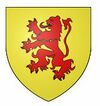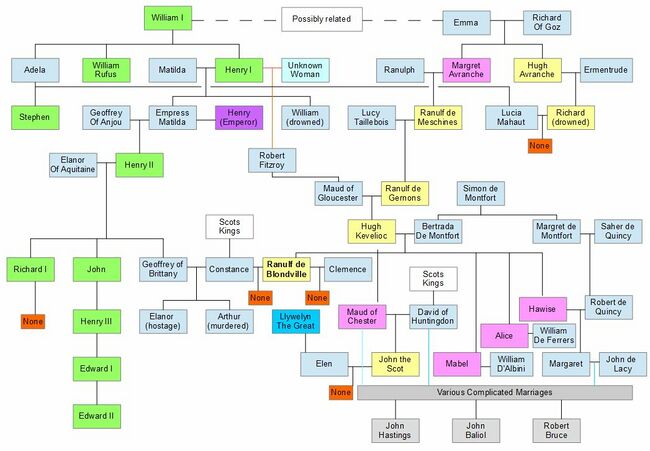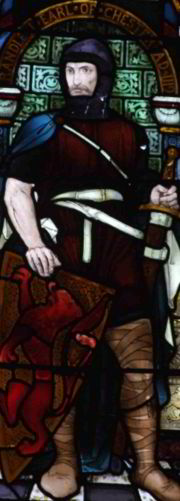Ranulf de Meschines
Ranulph de Meschines III "le Briquessart" (1121-1129: First Earl, Second creation)
(Kings: Henry I)
Summary
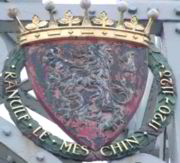
Born circa 1074 at Briquessart, Livry, France. An indirect inheritor, Ranulph "le Meschin" (the Younger), Earl of Chester was also Vicomte de Bayeux. He was also known as Ranulph de Briquessart. He succeeded to the title of Vicomte d'Avranches on 25 November 1120 and was created Earl of Chester in 1121. He appears to have remained staunchly loyal to Henry I and was Commander of the Royal forces in Normandy in 1124. He died either on 17 or 27 January 1128 at Chester and is buried at St. Werburgh's, Chester. His wife, Lucy survived him, and in 1130 paid 500 marks to King Henry I for a license to remain unmarried for 5 years.
- Parents: Ranulph Meschines, Viscount of Bessin (the area around Bayeux) and Maud (Margaret d'Avranches) sister of Hugh of Avranches - Gherbod the Fleming has beeen suggested as a father but this is very unlikely. Ranulf was thus, in addition to being heir to the Bessin, the nephew of one of Norman England's most powerful and prestigious families.
- Spouse: Lucy D'AVRANCHES Countess of Chester. Ranulf DE BRIQUESSART "Le Meschin", Earl of Chester and Lucy D'AVRANCHES Countess of Chester were married about 1098. The ancestry of Lucy has been the subject of much debate.
- Children: Adelize/Alice DE GERNON, Ranulph De Gernon Viscount d'Avranches, Earl of Chester.
Ranulf de Meschines has somewhat confusing "attributed" arms which were, on the Queens Park Suspension Bridge, a white lion on a red ground before restoration and, in the stained glass of the Town Hall, possibly a red lion on a gold ground. To add further confusion some versions of the arms of his son Ranulph De Gernon (shown in the stained glass pictured on his page) and that shown on the bridge also differ. The arms of the father and son seem to have been mixed up on the Suspension Bridge. The arms on the lodge in Grosvenor Park originally did help much as they also show that the father and son had oppositely coloured arms, but in this case they had become blue and gold! The arms on the lodge have now been "corrected" by not copying the mistaken arms on the Suspension Bridge, although one of the lions is still gold when it should be silver. Of course, at the time of Ranulf heraldry had not emerged and the coats of arms were "attributed" much later, possibly in the Tudor period.
Before Chester
Ranulf only became earl at the rather advanced age of 51 (in 1120). Prior to this Ranulf served the English king as a kind of semi-independent governor in Cumberland and Westmorland, though he lacked the formal status of being called such. A contemporary illustration of this authority is one charter in the records of Wetheral Priory, which recorded Ranulf addressing his own sheriff, "Richer" (probably Richard de Boivill). A source from 1212 attests that the jurors of Cumberland remembered Ranulf as quondam dominus Cumberland ("sometime Lord of Cumberland").
Ranulf's earliest appearance in surviving historical records was 24 April 1089, the date of a charter of Robert Curthose, Duke of Normandy, to Bayeux Cathedral. Ranulf, as "Ranulf son of Ranulf the viscount", was one of the charter's witnesses. He appears again c. 1093/4, as a witness to the supposed foundation charter of Chester Abbey, granted by his uncle Hugh of Avranches. By 1101 William the Conqueor's sons, Robert Curthose and Henry I were still fighting, and Robert led an invasion to oust his brother Henry. Ranulph threw in his lot with Henry and was entrusted with collecting oaths of support. Robert landed at Portsmouth with his army, but the lack of popular support among the English (Anselm, the archbishop of Canterbury, was decidedly against him and the Charter of Liberties issued at Henry's coronation was well liked - if largely ignored by monarchs) as well as Robert's own mishandling of the invasion tactics enabled Henry to resist the invasion. Robert was forced by diplomacy to renounce his claim to the English throne in the Treaty of Alton. It is said that Robert was a brilliant field commander but a terrible strategist in the First Crusade.
Between 1098 and 1101, probably in 1098, Ranulf became a major English landowner in his own right when he became the third husband of Lucy of Bolingbroke, heiress of the honour of Bolingbroke in Lincolnshire. Such a marriage would require royal patronage and the exact date of it is important given that Henry I only became king in August 1100.
This marriage brought him the lordship of Appleby in Cumberland, previously held by Lucy's second husband (Roger fitzGerold, de Roumare). He promptly constructed Appleby Castle. Originally this would have been an earth ringwork and bailey fortress. The square stone keep of Appleby is one of the best preserved examples of its type and was added in 1170 (by Hugh de Morville). It is known as "Caesar's Tower" - this is similar to the Agricola Tower at Chester Castle neither of which had anything to do with the Romans. Ranulf ceded Appleby to the crown when he became earl of Chester. The castle was still in royal hands when the Scottish king, William the Lion, invaded the Eden Valley in 1174 and the constable of the castle surrendered without a fight.
Ranulfs family (his brother William) also constructed Egremont Castle. He had an older brother (Richard) who died in youth.
In 1106 Ranulf founded Wetheral Priory, a Benedictine monastic house of which only a gatehouse survives. He was at the Battle of Tinchebray (28 September 1106) the same year, where he was known as Ranulf of Bayeux. He led one of groups into which Henry I's forces were split. The battle effectively ended the efforts of Robert Curthose to contest the inheritance of his brother Henry. Most of Robert's army was captured or killed. Those captured included Robert, Edgar Ætheling (uncle of Henry's wife), and William, Count of Mortain. Most of the prisoners were released, but Robert Curthose and William of Mortain spent the rest of their lives in captivity. Robert Curthose had a legitimate son, William Clito (1102–1128), whose claims to the duchy of Normandy led to several rebellions which continued through the next part of Henry's reign.
Henry faced a particularly dangerous situation in 1118 having been defeated by Fulk V and the Angevin army, supporters of Louis VI of France. Forced to retreat, Henry's position deteriorated alarmingly, as his resources became overstretched and more barons abandoned his cause. Fulk then allied with Henry when he arranged for his daughter Matilda of Anjou to marry Henry's son William Adelin. Fulk went on a pilgrimage to Jerusalem in 1119 or 1120, and became attached to the Knights Templar. Orderic Vitalis makes it clear that Richard of Avranches and Ranulf were among a very small number who remained loyal to Henry in 1119.
An indirect claim
In 1121, following the loss of the White Ship, the earldom passed through the First Earl Hugh's sister Maud to the drowned Richard of Avranches's first cousin Ranulf. Merely four days before the disaster, Ranulf and cousin Richard had witnessed a charter together at Cerisy. Ranulf was not simply given the earldom, but had to surrender the bulk of the lands of his wife, Lucy and his own lands at Carlisle. One person who was unhappy with this was William de Roumare, the son of Lucy by her previous husband who quarrelled violently with the King about his mother's inheritance, and, crossing to Normandy, vented his wrath on the country around his castle of Neufmarché. He also joined in the rebellion of 1122 led by Waleran de Beaunont, Count of Meulan and others in support of William Clito, and opposed the King until the latter, in about 1127, restored a part of what he claimed. Thereafter he became a favourite companion of the King. The "The history and gazetteer of the county of Derby" by Stephen Glover, relates the events:
- Ranulph de Bricasard, the third earl of Chester, by his marriage with Lucia, the sister of the celebrated Edwyn and Morcar, the sons of Algar, duke of Mercia, seems to have strengthened his claims to the inheritance of lands, torn from those illustrious Saxons, and conferred by the Conqueror on his uncle Hugh Lupus, by this alliance. He certainly conciliated the attachment of the remaining English tenantry connected with a family so high in their estimation. Lucia had been twice married before: first, to Ivo Tailbois, a rude and imperious Norman adventurer, by whom she had an only daughter, who died young: secondly, to Roger de Romara, earl of Lincoln, by whom she had William de Romara, who held several high military appointments under king Henry the First. On his mother's third marriage, which was with Ranulph de Bricasard, he laid claim to her possessions, but Ranulph having placed them, as the dowry of his wife, under the wardship of the crown, and engaged to pay a very heavy sum for their recovery, his suit was rejected. Enraged at this injustice, he went over to Normandy, and joined the insurrection which had broken out in that country in favour of William, the son of duke Robert. There he continued in open hostilities for two years, when king Henry, to pacify him, not only gave him those manors in Lincolnshire, which had belonged to his mother, but also bestowed upon him the hand of a wealthy royal ward, Matilda, the daughter of Richard de Redvers.
Chester's annual fair was reorganized by Ranulf, who provided new regulations governing its hours of opening. According to some sources St Giles Hospital was founded in the time of Ranulf, for lepers - it had a burial ground St Giles Cemetery, in which the heads of Welshmen killed in battle with Hugh de Kevelioc were reputed to have been buried in 1170 - although this is almost certainly an error due to a confusion of Boughton and Broughton - the battle in question having probably been at Balderton Bridge. Moreover, the hospital was most likely founded by Hugh de Kevelioc. Another foundation of Henry II.’s reign was the leper-hospital of St Mary Magdalen at Sponne, outside the walls of Coventry. It was founded by:
- ".. an Earl of Chester, who, having a certain leprous knight in his household, gave in pure alms for the health of his soul and the souls of his ancestors his chapel at Sponne with the site thereof, and half a carucate of land for the maintenance of such lepers as should happen to be in the town of Coventry. There was one priest to celebrate, and with him were wont to be also certain brethren or sisters together with the lepers, praying to God for the good estate of all their benefactors."
The earl in question is believed to have been Hugh de Kevelioc, and the knight who came down with leprosy, was the one that he has sent on crusade in his stead.
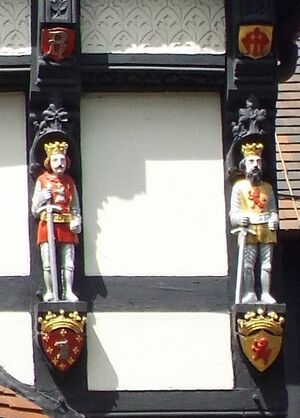
The Wirral
De Meschines was keen on hunting. He created Alan Sylvester chief forester of the forest of Wirral and granted to him the manors of Hooton, Storeton and Puddington to hold, upon condition that he performed the duties of forester and in addition that he blew or caused to be blown a horn at the Gloverstone in Chester on the morning of every fair day.
The "Wirral Horn" has apparently survived to the present day, and carries the following inscription, believed to have been added in the 17th Century:
- In the year 1120, Randal de Meschines, Earl of Chester, created Alan Sylvester chief forester of the forest of Wirral and granted to him the manors of Hooton, Storeton and Puddington to hold upon condition that he performed the duties of forester and in addition that he blew or caused to be blown a horn at the Gloverstone in Chester on the morning of every fair day, to indicate that the tolls on all goods bought or sold in the city or within the sound of that horn belonged to the Earl or his tenants. Alan Sylvester was succeeded by his son, Ralph, on whose death, without issue, Hugh Cyveliac, Earl of Chester, granted the same manors with the forestership to Alexander de Storeton on his marriage with Annabella, the daughter of Alan Sylvester. Alexander de Storeton again had only female issue and the forestership passed next to Sir Thomas Bamville, who married Agnes de Storeton, daughter of Alexander. Sir Philip Bamville, the heir of Sir Thomas, also left issue, three daughters only, the eldest of whom, Jane, married Sir William de Stanley, and brought the forestership as part of her dower, the title of her son, John Stanley, having been proved in 1346 before Jordan de Macclesfield, justice in Eyre to the Earl of Chester. In this family it remained until disafforested by King Edward 111 on the complaint of the citizens of Chester who represented that they were grievous sufferers from the freebooters who lurked in the forest. The Stanleys petitioned the king for renumeration for the loss of the profits attached to the office of chief forester, and were granted an annuity of twenty marks, which however seems to have been indifferently paid. The horn, however, which was the symbol of their tenure, has remained in the possession of the Stanley family ever since.
While the inscription on the horn blames the "disafforestation" of the Stanley's on the inhabitants of Wirral, the complaints, were actually by the residents of the Wirral about the wildness of the area and oppression by the Stanleys. A charter confirming the disafforestation of Wirral was issued by King Edward III on July 20, 1376. While the horn was displayed for a short while at the Wirral Museum it has since been returned to its permanent home at the Stanley ancestral seat in Drayton, Somerset. The forest of Wirral turns up in Arthurian legend - Sir Gawain spent Christmas on Wirral before his confrontation with the Green Knight.
- The wilderness of Wirral:
- few lived there
- Who loved with a good heart
- either God or man
See Cheshire Dialect for more on Gawain.
Who was Lucy?
Ranulf married (c.1090) a woman referred to as "Countess Lucy", (c.1079-1138), and she is now believed to have been the granddaughter maternally of William Malet, lord of Graville. Ranulph became the largest landholder in Lindsey through his marriage.
She has been the subject of much historical debate. Legend has it that Malet of Eye's mother was English, and that he was the uncle of King Harold II of England's wife Ealdgyth (the claim being that he had a sister Aelgifu who married Ælfgar, Earl of Mercia, who was the father of Ealdgyth). Legend also claims that William Malet buried Harold after the battle. A charter of Crowland Abbey, now thought to be spurious, described Thorold of Bucknall, perhaps the same as her probable father Thorold of Lincoln, as a brother of Godgifu (better known as Lady Godiva), wife of Leofric, Earl of Mercia. Other sources including a genealogia fundatoris of Coventry Abbey, claim Lucy is the daughter of Earl Aelfgar (therefore sister of Aldgyth, Edwin and Morcar and grand-daughter of Godiva). Actual literary confirmation of the identity of "Lucy" is difficult to come by. However:
- Ingulph's Chronicle of the Abbey of Croyland now simply called the Croyland Chronicle records that William I King of England arranged the marriage of "Ivo Taillebois" and "Lucia sister of Edwin and Morcar". The first section of the chronicle is now known to be a later forgery.
- Peter of Blois' Continuation of the Chronicle of the Abbey of Croyland records the death of Ivo and his burial at the priory of Spalding, and the remarriage of his widow "hardly had one month elapsed after his death" with "Roger Fitz-Gerold, Baron of Kendal, the son Gerald de Romar".
- She is named as wife of Ranulf by Orderic Vitalis, who also names her first husband, but does not give her origin.
- According to a charter of Henry Duke of Normandy (later Henry II King of England) issued in favour of her son Ranulph De Gernon, Earl of Chester and dated 1153, Countess Lucy was the niece of Robert Malet of Eye and of Alan of Lincoln, as well as kinswoman of Thorold "the Sheriff".
A further William Malet (died c. 1121) was the third of his family to hold the honour of Eye and the lordship of Granville. He was either the younger brother, son, or nephew of Robert Malet, in other words, either a son or grandson of the first William Malet. He forfeited his English lands and was banished sometime between his father's death (c. 1106) and 1113. Several other barons lost their lands in 1110, so that year is likely. The precise cause is not known, but probably it is connected with the conflicts between Henry and King Louis VI of France during that period or possibly the 1110 revolt of Philip de Braose.
If it were true that Lucy was descended from the Saxon earls of Chester, Ranulphs marriage to Lucy would ensure that his son, Ranulph De Gernon, was descended from Mercian earls. His son's subsequent marriage to a descendent of Henry I would mean that the next generation, Hugh de Kevelioc could claim ancestry from both English and Norman nobility.
Norman Rebellions
By 1124, as mentioned above, a serious aristocratic rebellion (the Second Norman Rebellion) broke out in Normandy in favour of William Clito, but the rebels were defeated as a result Henry’s intelligence network and the lack of organisation of the leaders, who were defeated at the Battle of Bourgthéroulde in March 1124. Clito's claim became even stronger in 1120 with the loss of the White Ship and the death of Henry I's only legitimate son - he became the obvious male heir to England and Normandy. Earl Ranulph commanded at least a part of the royal forces righting against the rebels. Ranulph had also benefited from the White Ship as his cousin Richard had drowned - leading to Ranulph's succession through his mother Maud, sister of Hugh of Avranches.
It has also been suggested that Ranulph was responsible for the capture of both Amaury de Montfort, (son the original Simon de Montfort count of Evreux) and Waleran de Meulan (Earl of Worcester) - others have them captured by William de Tancarville or Odo Borleng. In one version of events Amaury was captured fleeing the field by William de Grandcourt, and, rather than turn over his prisoner to Henry, however, William decided to go into exile with Amaury.
- The campaign of 1124 opened with a spirited ride by the leading insurgents from Beaumont to relieve Fatouville, a small castle near the mouth of the Seine, which was being attacked by the King's men. After a night's march the barons reached the place in safety, namely on the morning of the 25th March, and threw in supplies. The return journey, however, next day was less successful. Near Bourgtheroulde they found the Earl of Chester waiting to receive them with 300 men. Following his master's tactics he had dismounted part of his men-at-arms to fight on foot, with the archers posted in front of them, the rest of the men-at-arms remaining on horseback. On viewing these dispositions Amaury, as a man of years and experience, swore 'By all the nations' -his usual oath- that they ought not to fight. But Waleran, with all the cheery confidence of youth, insisted on charging with forty men-at-arms, and was utterly discomfited, the horses being disabled by the fire of the archers. The end of it was that he, with two of his brothers-in-law, and some eighty men in all, were carried off in triumph. - The Foundations of England: Or, Twelve Centuries of British History (B.C. 55-A.D. 1154) Vol. 2 James H. Ramsay;
A descendant of Simon (I) de Montfort would later (briefly) become Earl of Chester. Waleran was released for unknown reasons in 1129. He resumed an active role at court and he and his twin brother were both present at Henry I's deathbed (Henry famously died (1135) from eating "a surfeit of lampreys"). As for Amaury, Henry I King of England "took the county of Evreux into his own hands" because he "had forfeited the king's favour by his effrontery". However Amaury made peace with the King later that same year and for the rest of Henry's reign remained on good terms with him.
It has been suggested that during the revolt, Louis VI was distracted from active intervention because Henry I got his son-in-law, the Holy Roman Emperor Henry V, to threaten Louis from behind. Bourgetheroulde was a particularly messy battle - afterwards Henry decided to blind three of the more important prisoners. Charles the Good, count of Flanders, objected to the king, believing it was wrong to punish knights in this fashion. Henry replied that two of these prisoners were his own liegemen and that they had betrayed him by going to war against him, therefore deserving a punishment of death or mutilation. As for the third captive, Luke of La Barre, he had mocked Henry with scurrilous songs, and that if blind, he would give up this practice and provide an example for others. Perhaps Luke knew what his fate would be, so he ended his own life in dramatic fashion, by beating his head against the stone wall of his prison cell, until he fell dead.
Henry V is supposed to have died at Utrecht on 23 May 1125 although some sources cite him as the mysterious Anchorite who lived in the Hermitage at Chester. See the page on Godstall Lane for more on him.
Harold's Gold?
If anyone is into Anglo-Norman conspiracy theory there is a story in here somewhere: - a relative of the English King supposedly buries him (although the body could only be recognised by his wife) - the wife then flees to just where - Chester:
- Immediatlie after he [William] had thus got the victorie in a pight field (as before ye haue heard) he first returned to Hastings, and after set forward towards London, wasted the countries of Sussex, Kent, Hamshire, Southerie, Middlesex, and Herefordshire, burning the townes, and sleaing the people, till he came to Beorcham. In the meane time, immediatlie after the discomfiture in Sussex, the two earles of Northumberland and Mercia, Edwin and Marchar, who had withdrawne themselues from the battell togither with their people, came to London, and with all speed sent their sister quéene Aldgitha vnto the citie of Chester, and herewith sought to persuade the Londoners to aduance one of them to the kingdome: as Wil. Mal. writeth. (Holinshed)
..and there is the story that Harold isn't dead after all but living in the Hermitage in ...Chester.
And then the Malet family fall out of favour and their lands go to the Earl of ... Chester.
And who (back in 1071) had written to console the daughter of William I who had possibly been jilted by Harold and became a nun? - sources show that it was Anselm of Bec - later to found the Benedictine Abbey ... at Chester
There are other possible twists to the tale. Harold (house of Wessex) and the Earls of Chester and Northumbria (Leofric's House) had fair warning of the potential for war in 1066 and would have been well advised to make preparations to hide any gold and other treasures which they might have had. At least one hoard has been associated with Harold's brother.
Loss of lands to the Scots
It was not all plain sailing for the earl. In his first act as king David of Scotland (1124) made a grant or perhaps a reaffirmation of a previous grant to one of his followers, Robert de Brus, of the lordship of Annandale, on the frontier between his old principality and the lands of "Galloway":
- David, by the grace of God King of Scots, to all his barons, men and friends, English and French, greetings. Know you that I have given and granted to Robert de Brus Ystrad Annan (Annandale) and all the land from the boundary of Dunegal of Srath Nid (Nithsdale) to the boundary of Randolph le Meschin; and I will and grant that he should hold and have that land and its castle well and honourably with all its customs which Ranulph le Meschin ever had in Carduill (Carlisle) and in his land of Cumberland on that day in which he had them most fully and freely. Witnesses: Eustace fitz John, Hugh de Morville, Alan de Perci, William de Somerville, Berengar Engaine, Randolf de Sules, William de Morville, Hervi fitz Warin and Edmund the chamberlain. At Scone.
Clearly "de Meschin" had lost land in the region. Ranulf died in January 1129, and was buried in Chester Abbey (now the [Cathedral]). He was survived by his wife and countess, Lucy, and succeeded by his son Ranulph De Gernon. A daughter, Alicia, married Richard de Clare, a lord in the Anglo-Welsh marches.
Sources and Links
Related Pages
Online
- Ormerod on Ranulf I
- Cyril Hurt, "William Malet and His Family," Anglo-Norman Studies XIX
- Katherine S. B. Keats-Rohan, "Antecessor Noster: The Parentage of Countess Lucy Made Plain", Prosopon, issue 2
- www.geni.com - lifts the entire contents of this site.


